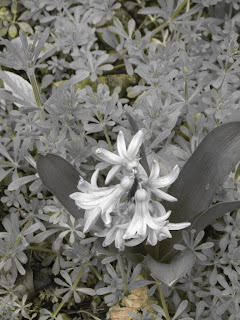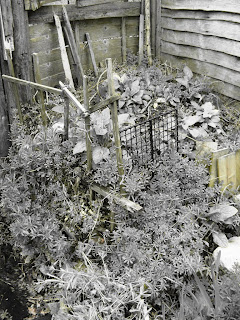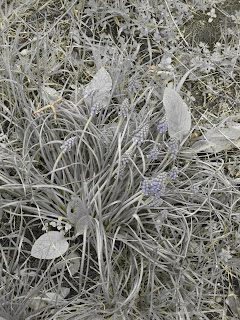
The first day I was in England, I took photos of the garden intending to use them in a couple of posts. But I must have done something weird with the camera settings, because they came out in shades of grey with only the odd coloured tint.

The neurologist Oliver Sacks (remember Robin Williams and Robert de Niro in the film Awakenings?) describes the experience of total colour-blindness in one of his books. He talks about a visit to an island in the South Pacific where the population is congenitally colour blind, as well as also mentioning the experience of one of his patients who had lost colour vision after a car accident which damaged part of his brain. He says that this patient , "... seemed to have lost the ability not only to see colour but also to imagine or remember it, even to dream of it... (He) complained of his world feeling impoverished, grotesque, abnormal - his art, his food, even his wife looked "leaden" to him."

Do these photos give some idea what it would be like? Knock out the suggestions of yellow and blue, and they are without doubt "leaden". Not black and white - just a grisly shade of grey.

The book is worth reading. Not only for the account of the colour blind island, but also for Sacks account of the cycads on the island of Guam.
Sacks had been a collector of Cycads since he was a child, and jumped at the chance to visit an island which was full of them, but also home to a neurological disorder called lytico-bodig - apparently caused by the poisonous effects of the plant. Cycads, in case youre not familiar with them, are plants which have been around for millions of years. Theyre the living dinosaurs of the plant world. Distantly related to palms and ferns, they grow in tropical and sub-tropical parts of the world where they are widely used as a food source, despite the fact that they are potent neuro-toxins, producing symptoms similar to those of Parkinsons disease. (If youve got any in your garden, dont be tempted to chomp on the plant as a snack.) Though all over the world people had apparently developed ways of detoxifying the plant, in Guam long-term effects seemed to remain. The rest is a detective story, told with Sacks usual humanity and compassion for the sufferers of the diseases he describes. Its a detective story with no solution, but well worth reading both for the botantical and the neurological details.

But back to colour blindness. What would it be like to garden, seeing only this? Sacks describes the reactions of Knut Nordby, a colour-blind scientist who accompanied him, and of James, one of the islanders :
Knut was fascinated by ... the richness of the vegetation, which he saw quite clearly, perhaps more clearly than the rest of us. For us, as colour-normals, it was was at first just a confusion of greens, whereas to Knut it was a polyphony of brightnesses, tonalities, shapes and textures, easily identified and distinguished from each other. He mentioned this to James who said it was the same for him and all the other achromatopes on the island - none of them had any difficulty distinguishing the plants on the island....
"But what about bananas..." Bob asked... " How can you tell when a banana is ripe ...?"
James answer was to go to a banana tree and to come back with a caully selected, bright green banana for Bob.
Bob peeled it; it peeled easily to his surprise. He took a small bite of it, gingerly; then devoured the rest.
"You see," said James, "We dont just go by colour. We look, we feel, we smell, we know - we take everything into consideration, and you just take colour!"




0 comments:
Post a Comment